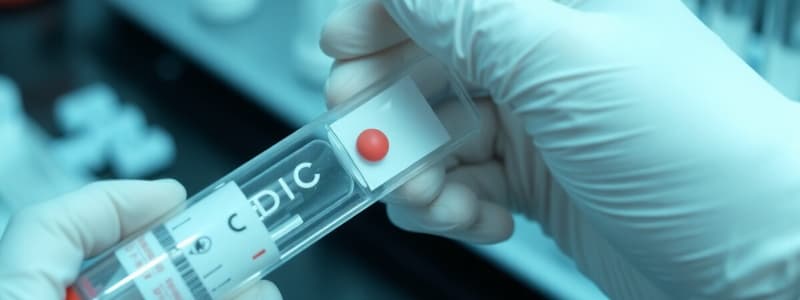Podcast
Questions and Answers
What is a key characteristic of laboratory testing in DIC?
What is a key characteristic of laboratory testing in DIC?
- Increased fibrinogen levels
- Increased white blood cell count
- Decreased platelet count (correct)
- Elevated hemoglobin levels
Which laboratory finding is NOT associated with DIC?
Which laboratory finding is NOT associated with DIC?
- Increased D-dimer levels
- Decreased platelet count
- Normal platelet count (correct)
- Prolonged prothrombin time
When evaluating a patient for DIC, what would you expect the platelet count to be?
When evaluating a patient for DIC, what would you expect the platelet count to be?
- Normal
- Unpredictable
- High
- Low (correct)
In the context of DIC, which of the following statements is accurate?
In the context of DIC, which of the following statements is accurate?
What might decreased platelet counts in DIC indicate about the patient's clotting status?
What might decreased platelet counts in DIC indicate about the patient's clotting status?
Which of the following laboratory findings is least likely to be associated with DIC?
Which of the following laboratory findings is least likely to be associated with DIC?
What implication does a decreased platelet count in DIC suggest regarding the patient's hemostatic function?
What implication does a decreased platelet count in DIC suggest regarding the patient's hemostatic function?
Which factor is primarily responsible for the observed laboratory abnormalities in DIC?
Which factor is primarily responsible for the observed laboratory abnormalities in DIC?
How does a decreased platelet count in DIC typically affect the patient's clinical presentation?
How does a decreased platelet count in DIC typically affect the patient's clinical presentation?
In the context of DIC, which laboratory test would most directly indicate a significant change in platelet function?
In the context of DIC, which laboratory test would most directly indicate a significant change in platelet function?
Flashcards are hidden until you start studying
Study Notes
DIC Lab Testing
- Laboratory testing in DIC is characterized by consumption of clotting factors and platelets.
- A normal laboratory finding in DIC is increased erythrocyte sedimentation rate (ESR).
- Decreased platelet count in DIC indicates severe clotting problems and bleeding risk.
- DIC results in the paradoxical occurrence of excessive clotting and bleeding.
- Decreased platelet counts in DIC can signify thrombocytopenia, indicating impaired platelet function.
- Decreased fibrinogen levels are least expected in DIC.
- A decreased platelet count in DIC implies impaired hemostatic function, leading to increased bleeding.
- The primary culprit for DIC's lab abnormalities is activation of the coagulation cascade.
- Decreased platelet counts in DIC often manifest clinically as bleeding, particularly mucosal bleeding.
- Platelet aggregation studies directly evaluate platelet function changes in DIC.
Laboratory Testing in DIC
- A key characteristic of laboratory testing in DIC is consumption of clotting factors.
- Elevated D-dimer is a laboratory finding associated with DIC
- Elevated prothrombin time (PT) is a laboratory finding associated with DIC
- Elevated partial thromboplastin time (PTT) is a laboratory finding associated with DIC
- Decreased fibrinogen levels is a laboratory finding associated with DIC
- Increased fibrin degradation products (FDPs) is a laboratory finding associated with DIC
- A decreased platelet count is a laboratory finding associated with DIC
- Elevated levels of antithrombin III is NOT a laboratory finding associated with DIC
- Decreased fibrinogen levels may indicate widespread clotting and consumption of clotting factors.
- Decreased platelet count suggests impaired hemostatic function due to consumption or impaired production.
- Decreased platelet count in DIC may indicate an inability to form new blood clots.
- Decreased platelet count in DIC may result in bleeding.
- Consumption of clotting factors is primarily responsible for the observed laboratory abnormalities in DIC.
- Platelet count would most directly indicate a significant change in platelet function.
Studying That Suits You
Use AI to generate personalized quizzes and flashcards to suit your learning preferences.




